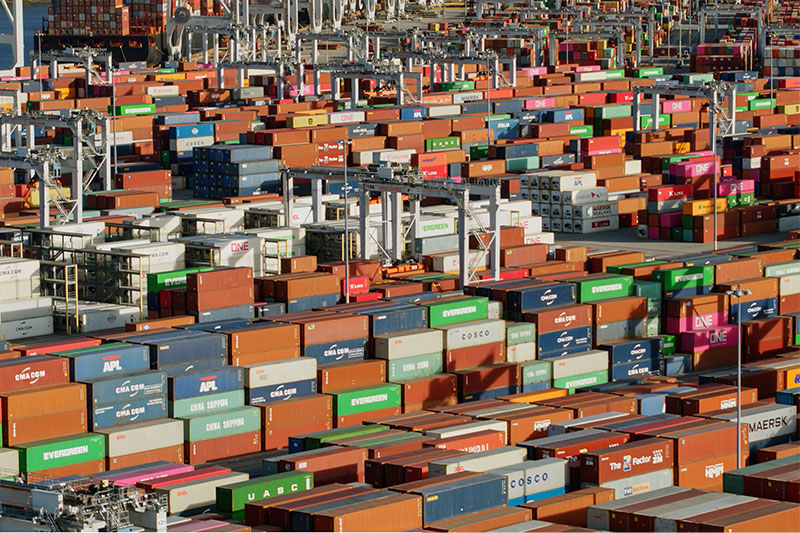Port Tracker report points to ongoing slowing of imports, with retailers’ inventories at high levels

The new edition of the Port Tracker report, which was released today by the National Retail Federation (NRF) and maritime consultancy Hackett Associates, picked up where its previous edition left off, with retail container port volumes expected to see declines off of record monthly volumes posted earlier this year.
The ports surveyed in the report include: Los Angeles/Long Beach; Oakland; Tacoma; Seattle; Houston; New York/New Jersey; Hampton Roads; Charleston, and Savannah; Miami; Jacksonville; and Fort Lauderdale, Fla.-based Port Everglades.
Authors of the report explained that cargo import numbers do not correlate directly with retail sales or employment because they count only the number of cargo containers brought into the country, not the value of the merchandise inside them, adding that the amount of merchandise imported provides a rough barometer of retailers’ expectations.
“Cargo levels that historically peak in the fall peaked in the spring this year as retailers concerned about port congestion, port and rail labor negotiations and other supply chain issues stocked up far in advance of the holidays,” NRF Vice President for Supply Chain and Customs Policy Jonathan Gold said in a statement. “With a rail strike possible this month, there are still challenges in the supply chain, but the majority of holiday merchandise is already on hand and retailers are well prepared to meet demand.”
For September, the most recent month for which data is available, import volume—at 2.03 million TEU (Twenty-Foot Equivalent Units)—fell 10.2% compared to August and were off 4.9% annually.
For the following months, Port Tracker issued the following projections:
- October, at 2.02 million TEU, for an 8.5% annual decrease;
- November, at 1.92 million TEU, for a 9.2% annual decrease (which would mark the lowest-volume month going back to 1.87 million TEU in February 2021);
- December, at 1.9 million TEU, for a 9% annual decrease;
- January, at 1.98 million TEU, for an 8.4% annual decrease; and
- February, at 1.71 million TEU, down 19.1%, from unusually high numbers in February 2021, when backed up cargo kept congested U.S. ports busy despite the annual Lunar New Year shutdown of Asian factories and it is expected to be the lowest volume month since June 2020’s 1.61 million TEU
Hackett wrote in the report that his firm expects the flattening of demand for both durable and non-durable goods that began around the middle of this year to continue into the first half of 2023.
“This will depress the volume of imports, which has already declined in recent months,” he wrote. “Meanwhile, carriers have begun to pull services and are looking at laying up ships, something which is only done when forward-looking cargo expectations are bleak. Export volumes from China, which account for around 30 percent of U.S. imports, have been declining since mid-year and China’s gross domestic product has weakened considerably. Both the global and U.S. economies are experiencing the highest inflation rates in 40 years. The choice is whether to live with elevated prices or suppress inflation by increasing interest rates in an attempt to diminish demand. The Federal Reserve has opted for raising interest rates, fully aware that this will be harmful for consumers and home buyers. This may well lead to a recession early next year, although hopefully only a mild one with a soft landing. We continue to keep an eye on other potential headwinds that exist, from ongoing labor negotiations in both the port and rail sectors to a geographic expansion of the conflict in Ukraine.”

Article Topics
3PL News & Resources
FTR Shippers Conditions Index enters negative territory DAT March Truckload Volume Index sees modest March gains National diesel average, for week of April 22, is down for the second straight week UPS reports first quarter earnings declines LM Podcast Series: Assessing the freight transportation and logistics markets with Tom Nightingale, AFS Logistics Investor expectations continue to influence supply chain decision-making XPO opens up three new services acquired through auction of Yellow’s properties and assets More 3PLLatest in Logistics
FTR Shippers Conditions Index enters negative territory DAT March Truckload Volume Index sees modest March gains National diesel average, for week of April 22, is down for the second straight week UPS reports first quarter earnings declines LM Podcast Series: Assessing the freight transportation and logistics markets with Tom Nightingale, AFS Logistics Investor expectations continue to influence supply chain decision-making The Next Big Steps in Supply Chain Digitalization More LogisticsAbout the Author
Subscribe to Logistics Management Magazine

Find out what the world's most innovative companies are doing to improve productivity in their plants and distribution centers.
Start your FREE subscription today.
April 2023 Logistics Management

Latest Resources














